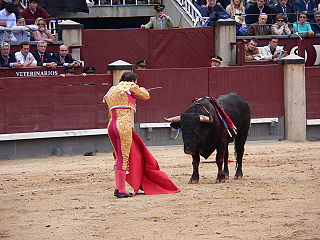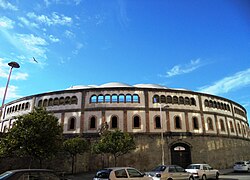
A bullring is an arena where bullfighting is performed. Bullrings are often associated with the Iberian Peninsula, but they can also be found through Iberian America and in a few Spanish and Portuguese ex-colonies in Africa. Bullrings are often historic and culturally significant centres that bear many structural similarities to the Roman amphitheatre.

Francisco Rivera Pérez, better known as Paquirri, was a Spanish bullfighter. He died after being gored by a bull named Avispado at the Pozoblanco bullring. During his career, he was six times borne shoulder-high out through the Great Gate at Las Ventas.

The Plaza de Torosde Acho is the premier bullring in Lima, Peru. Located beside the historical center of the Rímac District, the plaza is classified as a national historic monument. It is the oldest bullring in the Americas and the second-oldest in the world after La Maestranza in Spain. It opened on 30 January 1766.

Spanish-style bullfighting is a type of bullfighting that is practiced in several Spanish-speaking countries: Spain, Mexico, Ecuador, Venezuela, Peru, as well as in parts of southern France and Portugal. In Colombia it has been outlawed but is being phased out with a full ban coming in effect in 2027. This style of bullfighting involves a physical contest with humans attempting to publicly subdue, immobilize, or kill a bull. The most common bull used is the Spanish Fighting Bull, a type of cattle native to the Iberian Peninsula. This style of bullfighting is seen to be both a sport and performance art. The red colour of the cape is a matter of tradition – bulls are color blind. They attack moving objects; the brightly-colored cape is used to mask blood stains.
CAS International is an international non-profit advocacy group which aims to end bullfighting. CAS International was founded in 1993 as Comité Anti Stierenvechten, with the help of ADDA from Barcelona, Spain, De Dierenbescherming and the international animal welfare organisation WSPA originally aimed at stopping Dutch tourists from going to bullfighting.

Bullfighting is a physical contest that involves a bullfighter attempting to subdue, immobilize, or kill a bull, usually according to a set of rules, guidelines, or cultural expectations.
Bullfighting was banned in the Spanish autonomous community of Catalonia by a vote of the Catalan Parliament in July 2010. The ban came into effect on 1 January 2012. The last bullfight in the region took place on 25 September 2011 at La Monumental. The ban was officially annulled for being unconstitutional by Spain's highest court on 5 October 2016. However, despite the overturning of the ban, no further bullfight had taken place in Catalonia as of July 2020.

The Plaza de Toros de La Merced is a bullring in the Andalusian city of Huelva, Spain. The current building, which was reinaugurated in 1984 after being rehabilitated by architect Luis Marquínez, is an updated version of an old bullring, built in the years 1899 to 1902 and designed by architect Trinidad Gallego y Díaz. For years, it stood empty as bullfights were instead held at another, newer bullring that eventually had to fall to the wrecker's ball when it turned out to be unsafe. In its more than one hundred years of existence, the Merced bullring has borne witness to not only authentic glory in the Bull Festival, but also to the bullfighting figures from all eras who have filed through it. The rehabilitated bullring's foreseen capacity was 10,000, but its actual current capacity is 7,127.

La Malagueta is a bullring at Málaga, Andalucía, Spain. It is located in the eastern district of Málaga, in its namesake neighbourhood of La Malagueta.
Víctor Barrio Hernanz, known as Víctor Barrio, was a Spanish bullfighter who died at the age of 29 when he was gored in the chest by a bull named Lorenzo at the Teruel bullring.
Miguel Báez Espuny, better known as "El Litri", was a Spanish bullfighter, a descendant of one of Huelva's foremost bullfighting dynasties.

Iván Fandiño Barros was a Spanish bullfighter. He died when a bull named Provechito gored him during a bullfight at the bullring in Aire-sur-l'Adour in the south of France, only 343 days after fellow Spanish bullfighter Víctor Barrio had met the same fate.

The church of the Pilgrim Virgin is a scallop-shaped Roman Catholic chapel located in the city of Pontevedra, in Spain, along the route of the Portuguese Way of St. James.
Pablo Lozano Martín, commonly known as La Muleta de Castilla, was a Spanish bullfighter and fighting bull cattle rancher, owner of cattle raising Alcurrucén and "Hermanos Lozano".

The Praza da Ferrería is a large square located on the edge of the old town of Pontevedra (Spain), inside the old city walls. It is the main square of the old town and has an area of about 2,000 m2. It includes the small squares of the Estrella on the north side, the Orense square on the south side and the Casto Sampedro square on the east side, making a total of almost 5,000 m2.

Fuengirola Bullring is a 3rd category bullring located in Fuengirola, a coastal town in the province of Málaga, part of the autonomous community of Andalusia, Spain. The plaza is known for hosting traditional bullfights, as well as other cultural and entertainment events, such as concerts, theatrical performances, and exhibitions. It serves as an important venue for cultural exchange and a symbol of Spanish tradition and history.
Ángel Teruel Peñalver, professionally known as Ángel Teruel, was a Spanish bullfighter, the star of the escalafón taurino in the 1960s and early 1970s.

Rafael Cerro Ginés is a Spanish bullfighter who is currently active in the world of tauromachy, albeit in a more managerial capacity nowadays.
Jesús Martínez Barrios, known as Morenito de Aranda is a Spanish bullfighter. Born in a small town in Burgos, he had no family background in bullfighting, but has nonetheless become a well known matador in his own country and abroad. His interests also extend to raising the very cattle that he fights at a farm that he established.

Antonio Chenel Albadalejo, professionally and popularly known as Antoñete, was a Spanish bullfighter. His family had no background in bullfighting beyond Antoñete's father having been a monosabio.























